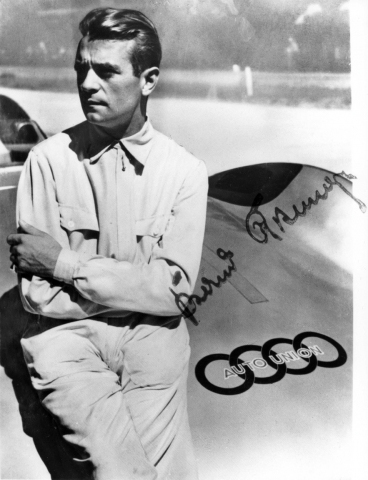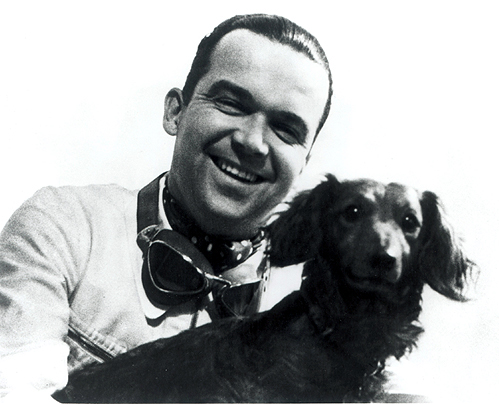"As long as you've got wheels and a license, it's open to you. Yes, you. But careful. You still have to play by the rules. For me, the car park at the Nordschliefe is as mad as the track. All "

Rosemeyer V Caracciola
Man has always been fascinated by speed. The desire to be the fastest has inspired tales of great heroism as well as great tragedy.
Perhaps the latter’s most poignant example was the fate that befell poor Bernd Rosemeyer as he faced off for Auto Union against Rudolf Caracciola and Mercedes Benz for the honour of being the fastest ever on a public road.
Rosemeyer was the son of a garage and repair shop owner and relatively inexperienced when he started racing for Auto Union. The seeds of rivalry with Caracciola were sown early on when, in just his second Grand Prix, Rosemeyer took the lead from Caracciola on the formidable 14-mile Nurburgring Nordschleife. He was within touching distance of the win when he missed a gear but, along with Tazio Nuvolari, became renowned as one of few who could tame the difficult Auto Unions.
He later made amends by scoring a hat-trick of Nurburgring wins. His celebrity rose when, after a win at Brno in 1935, he was introduced to the young flying ace Elly Beinhorn, who he married. She taught him how to fly and the Nazi party made full capital out of the publicity potential when Heirich Himmler made him a member of the SS – although it was doubtful whether Rosemeyer ever wore a uniform.

Rosemeyer’s chiselled features were perfect for the Nazi propaganda machine
In 1937 Mercedes had enjoyed most of the glory on the track but Auto Union at least managed to salvage some pride with a number of international speed records set by Rosemeyer. Shortly though, came news that Mercedes would try to beat them on the Frankfurt-Darmstadt motorway before the Berlin Motor Show scheduled for February 17, 1938.
Auto Union felt compelled to take up the challenge, not least because the German Nazi Motorsport Guild gave permission to close the road for both companies free of charge. On that fateful morning of January 28, 1937, Caracciola went first and set a new record speed of 432kph (268mph).
To put that into perspective, Malcolm Campbell had been first to take the land speed record over 300mph with his Bluebird on the Bonneville Salt Flats in Utah, on September 3, 1935. Just over two years later George Eyston’s Thunderbird did 312mph in Utah. That though, was on the unconfined expanse of the salt flats. There was still kudos to be had by going close to that on a public road, which was much more demanding.

The usurper of the Rosemeyer crown
Rosemeyer did not match Caracciola on his first two runs and when he began his final, fateful, attempt slightly before midday, the wind had picked up, a factor many felt was vital to what followed.
There was a fairly rudimentary understanding of aerodynamics in the thirties and whether it was a sidewind that hit Rosemeyer as he reached a clearing or unstable aerodynamics is open to debate, but the end result is that the car skidded left, then went back right, plunged off the autobahn and threw Rosemeyer out on its second somersault. He died at the roadside.
Since his 1937 records Auto Union had found another 35bhp through enlarged capacity and had fitted larger tyres on 24 inch wheels. That meant that the wheel fairings needed modifying and the car had altered ground clearance and stiffer suspension. When Rosemeyer climbed aboard that morning, the combination of engine, transmission, suspension, wheels, tyres and aerodynamic configuration was effectively untried and there were those who accused Auto Union of chasing records without proper preparation in a desperate attempt to counter the Mercedes challenge.
Rosemeyer’s death focused attention on the safety requirements of future speed attempts although he was afforded a hero’s funeral to celebrate a life given up chasing excellence for the glory of Auto Union, Germany and the SS. A moving tribute was published in German newspapers bylined “Your friend, Rudolf Caracciola.”
Rosemeyer was barely in his grave, however, when attention turned to more businesslike matters. Insurance cover amounted to 67,500 marks, to go to Rosemeyer’s widow Elly and the two month old Bernd Jr. Then there was another 2,756 DM to cover the cost of the funeral. Seeing as how Rosemeyer was an officer, Auto Union wanted to know, could the SS see their way to footing half the bill? Some viewed it a shameful request on the part of those who’d sent Rosemeyer out.
Today, a memorial is located at the Rosemeyer rest stop on kilometer marker 508 of the southbound Frankfurt-Heidelberg autobahn, just past the Langen/Mörfelden off-ramp.
CLICK TO ENLARGE








